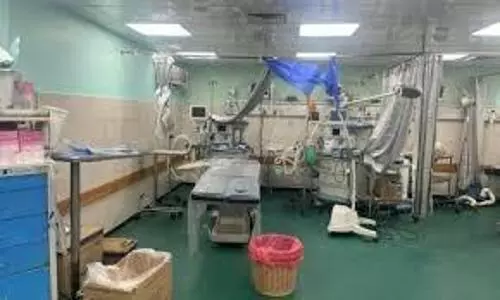
The controversial Medical Commission Bill
text_fieldsIt is needless to emphasise the hardships that befell the people following the strike by the doctors organized by the 2, 90, 000-member Indian Medical Association (IMA) for a few hours against the National Medical Commission ( NMC) Bill introduced in the Lok Sabha the other day.
But the reason that prompted allopathic practitioners across the country to go for this last resort is not trivial or something to be ignored. IMA points out that there are several provisions that are capable of exacerbating the already fragile national health sector to the maximum. IMA alleges that the Bill which recommends the formation of a new National Medical Council replacing the Medical Council of India (MCI) formed in 1934, would pave way for the collapse of the medical sector. The provision in the Bill that the practitioners in the field of alternative medicine such as ayurveda, unani and homeopathy, could practice allopathy after attending a short-term course is what has invited much criticism. At the same time, the MBBS graduates will have to clear a national level exam again for becoming eligible for practice. Secretary General of the World Psychiatric Association and former vice president Dr Abraham Kallivayalil points out that the unscientific NMC Bill which is anti-people. The government can regulate the fee structure of only up to 40 per cent of the seats in private medical colleges; the managements have the complete right to fix the fee structure for the remaining 60 per cent. He opines this will make medical education in the country highly expensive. It is also noteworthy that even associations from non-allopathic medical streams, such as Indian Homoeopathic Association, have expressed their disagreement with the bill. The system by which those who study ayurveda, homeopathy or unani clear the short-term bridge course which follow an entirely different stream, i.e. allopathy, and conduct their practice in it, would land the patients in trouble by failing to do justice to either. Though the Bill introduced in the Lok Sabha has been for referred in the interim to the consideration of the Lok Sabha standing committee, the Speaker has directed the committee to submit its report before the budget conference of the parliament. Whether any crucial changes would be recommended in the controversial provisions remains to be seen.
At the same time, the circumstances leading to the introduction of such a bill is not to be overlooked. In the rural areas of the country, where about 70 per cent of the population live, the health sector continues to be in a pathetic condition even afer seven decades of independence. According to the registration figures of World Health Organization (WHO) and Government of India, the doctor patient ratio during 2007-13 was seven for every ten thousand people. But official statistics apart, internal sources tell that in actual fact it is only 4.8 doctors per 10,000. In order to ensure a ratio of one doctor every 1,000 people, 14, 76,000 doctors will be required in 2030. And to meet this need, from the year 2014 to 2030, the number of doctors has to increase by 120 per cent. The situation in 2014 was such that, there was a deficit of 57,950 doctors to satisfy the requirement as per the public health standards of India, i.e. one doctor for every primary health centre, and nine doctors including specialists in community health centres. In rural areas alone, the actual doctor-patient ratio is 1.2 for 10,000 patients. Even in Kerala, purportedly a model for all India, doctors are generally reluctant to work in the rural sector. If one reason for this is the phenomenon of almost every MBBS graduate chasing the limited seats for PG courses, the other deterrent factor is the heavy workload in primary health centres where they have to work single-handed.
According statistics released by the Kerala Public Service Commission (PSC), in the last one and a half years, even after PSC sent advice memo of appointment for the post of Assistant Surgeon 16 times, out of 1981 candidates only 569 came forward to join service. If this is the state of affairs in Kerala, the less said the better about other states. In order to ameliorate this bad situation, in August 2014 a proposal of a three-year medical degree named BSc (Community Health) was mooted by the Central Government, but the government withdrew from it due to stiff opposition from the MCI, and IMA. Perhaps the plan envisaged in the new bill - of a short-term training programme in allopathic medicine for those from other streams of medicine – is an allotropic form of the shelved proposal. What both organizations opposing the new proposal, on strong reasons as they remain, should do is to put forward acceptable and feasible alternative plans. Mere opposition with a negative approach, whatever be the grounds, will not help a solution of the fundamental problem.























